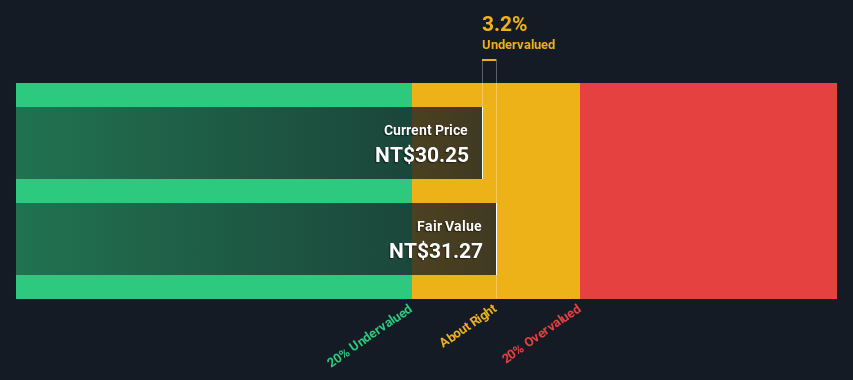- Taiwan
- /
- Infrastructure
- /
- TWSE:2633
Estimating The Intrinsic Value Of Taiwan High Speed Rail Corporation (TWSE:2633)

Key Insights
- Using the 2 Stage Free Cash Flow to Equity, Taiwan High Speed Rail fair value estimate is NT$31.27
- Taiwan High Speed Rail's NT$30.25 share price indicates it is trading at similar levels as its fair value estimate
- The average premium for Taiwan High Speed Rail's competitorsis currently 161%
Today we'll do a simple run through of a valuation method used to estimate the attractiveness of Taiwan High Speed Rail Corporation (TWSE:2633) as an investment opportunity by taking the forecast future cash flows of the company and discounting them back to today's value. The Discounted Cash Flow (DCF) model is the tool we will apply to do this. Before you think you won't be able to understand it, just read on! It's actually much less complex than you'd imagine.
We would caution that there are many ways of valuing a company and, like the DCF, each technique has advantages and disadvantages in certain scenarios. If you still have some burning questions about this type of valuation, take a look at the Simply Wall St analysis model.
View our latest analysis for Taiwan High Speed Rail
The Method
We're using the 2-stage growth model, which simply means we take in account two stages of company's growth. In the initial period the company may have a higher growth rate and the second stage is usually assumed to have a stable growth rate. In the first stage we need to estimate the cash flows to the business over the next ten years. Seeing as no analyst estimates of free cash flow are available to us, we have extrapolate the previous free cash flow (FCF) from the company's last reported value. We assume companies with shrinking free cash flow will slow their rate of shrinkage, and that companies with growing free cash flow will see their growth rate slow, over this period. We do this to reflect that growth tends to slow more in the early years than it does in later years.
A DCF is all about the idea that a dollar in the future is less valuable than a dollar today, so we need to discount the sum of these future cash flows to arrive at a present value estimate:
10-year free cash flow (FCF) estimate
| 2024 | 2025 | 2026 | 2027 | 2028 | 2029 | 2030 | 2031 | 2032 | 2033 | |
| Levered FCF (NT$, Millions) | NT$20.6b | NT$20.2b | NT$20.0b | NT$19.9b | NT$19.8b | NT$19.9b | NT$19.9b | NT$20.0b | NT$20.2b | NT$20.3b |
| Growth Rate Estimate Source | Est @ -3.25% | Est @ -2.03% | Est @ -1.18% | Est @ -0.58% | Est @ -0.16% | Est @ 0.14% | Est @ 0.34% | Est @ 0.48% | Est @ 0.59% | Est @ 0.66% |
| Present Value (NT$, Millions) Discounted @ 12% | NT$18.5k | NT$16.2k | NT$14.3k | NT$12.7k | NT$11.4k | NT$10.2k | NT$9.1k | NT$8.2k | NT$7.4k | NT$6.7k |
("Est" = FCF growth rate estimated by Simply Wall St)
Present Value of 10-year Cash Flow (PVCF) = NT$115b
After calculating the present value of future cash flows in the initial 10-year period, we need to calculate the Terminal Value, which accounts for all future cash flows beyond the first stage. For a number of reasons a very conservative growth rate is used that cannot exceed that of a country's GDP growth. In this case we have used the 5-year average of the 10-year government bond yield (0.8%) to estimate future growth. In the same way as with the 10-year 'growth' period, we discount future cash flows to today's value, using a cost of equity of 12%.
Terminal Value (TV)= FCF2033 × (1 + g) ÷ (r – g) = NT$20b× (1 + 0.8%) ÷ (12%– 0.8%) = NT$187b
Present Value of Terminal Value (PVTV)= TV / (1 + r)10= NT$187b÷ ( 1 + 12%)10= NT$61b
The total value, or equity value, is then the sum of the present value of the future cash flows, which in this case is NT$176b. The last step is to then divide the equity value by the number of shares outstanding. Compared to the current share price of NT$30.3, the company appears about fair value at a 3.2% discount to where the stock price trades currently. Remember though, that this is just an approximate valuation, and like any complex formula - garbage in, garbage out.

The Assumptions
Now the most important inputs to a discounted cash flow are the discount rate, and of course, the actual cash flows. Part of investing is coming up with your own evaluation of a company's future performance, so try the calculation yourself and check your own assumptions. The DCF also does not consider the possible cyclicality of an industry, or a company's future capital requirements, so it does not give a full picture of a company's potential performance. Given that we are looking at Taiwan High Speed Rail as potential shareholders, the cost of equity is used as the discount rate, rather than the cost of capital (or weighted average cost of capital, WACC) which accounts for debt. In this calculation we've used 12%, which is based on a levered beta of 2.000. Beta is a measure of a stock's volatility, compared to the market as a whole. We get our beta from the industry average beta of globally comparable companies, with an imposed limit between 0.8 and 2.0, which is a reasonable range for a stable business.
SWOT Analysis for Taiwan High Speed Rail
- Earnings growth over the past year exceeded the industry.
- Debt is well covered by earnings.
- Dividends are covered by earnings and cash flows.
- Dividend is low compared to the top 25% of dividend payers in the Infrastructure market.
- Current share price is below our estimate of fair value.
- Lack of analyst coverage makes it difficult to determine 2633's earnings prospects.
- Debt is not well covered by operating cash flow.
Looking Ahead:
Valuation is only one side of the coin in terms of building your investment thesis, and it is only one of many factors that you need to assess for a company. DCF models are not the be-all and end-all of investment valuation. Preferably you'd apply different cases and assumptions and see how they would impact the company's valuation. For example, changes in the company's cost of equity or the risk free rate can significantly impact the valuation. For Taiwan High Speed Rail, we've put together three fundamental items you should look at:
- Risks: Case in point, we've spotted 4 warning signs for Taiwan High Speed Rail you should be aware of, and 2 of them can't be ignored.
- Other Solid Businesses: Low debt, high returns on equity and good past performance are fundamental to a strong business. Why not explore our interactive list of stocks with solid business fundamentals to see if there are other companies you may not have considered!
- Other Environmentally-Friendly Companies: Concerned about the environment and think consumers will buy eco-friendly products more and more? Browse through our interactive list of companies that are thinking about a greener future to discover some stocks you may not have thought of!
PS. Simply Wall St updates its DCF calculation for every Taiwanese stock every day, so if you want to find the intrinsic value of any other stock just search here.
Valuation is complex, but we're here to simplify it.
Discover if Taiwan High Speed Rail might be undervalued or overvalued with our detailed analysis, featuring fair value estimates, potential risks, dividends, insider trades, and its financial condition.
Access Free AnalysisHave feedback on this article? Concerned about the content? Get in touch with us directly. Alternatively, email editorial-team (at) simplywallst.com.
This article by Simply Wall St is general in nature. We provide commentary based on historical data and analyst forecasts only using an unbiased methodology and our articles are not intended to be financial advice. It does not constitute a recommendation to buy or sell any stock, and does not take account of your objectives, or your financial situation. We aim to bring you long-term focused analysis driven by fundamental data. Note that our analysis may not factor in the latest price-sensitive company announcements or qualitative material. Simply Wall St has no position in any stocks mentioned.
About TWSE:2633
Taiwan High Speed Rail
Taiwan High Speed Rail Corporation constructs, operates, and manages a high-speed railway system and related facilities in Taiwan.
Second-rate dividend payer with questionable track record.
Market Insights
Community Narratives



